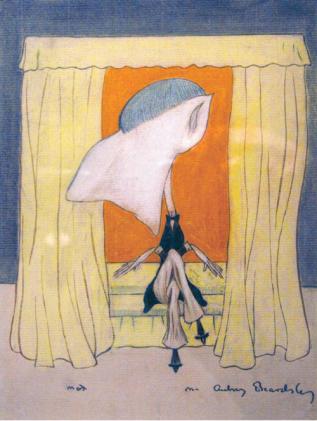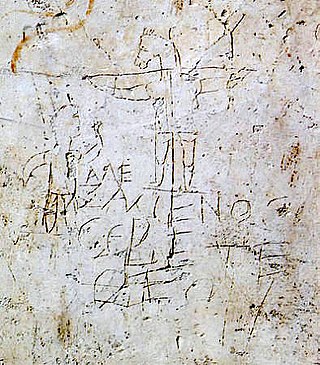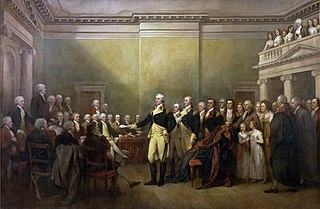Related Research Articles

The Articles of Confederation and Perpetual Union was an agreement among the 13 states of the United States, formerly the Thirteen Colonies, that served as the nation's first frame of government. It was debated by the Second Continental Congress at Independence Hall in Philadelphia between July 1776 and November 1777, and finalized by the Congress on November 15, 1777. It came into force on March 1, 1781, after being ratified by all 13 colonial states. A guiding principle of the Articles was the establishment and preservation of the independence and sovereignty of the states. The Articles consciously established a weak confederal government, affording it only those powers the former colonies had recognized as belonging to king and parliament. The document provided clearly written rules for how the states' league of friendship, known as the Perpetual Union, would be organized.

A cartoon is a type of visual art that is typically drawn, frequently animated, in an unrealistic or semi-realistic style. The specific meaning has evolved, but the modern usage usually refers to either: an image or series of images intended for satire, caricature, or humor; or a motion picture that relies on a sequence of illustrations for its animation. Someone who creates cartoons in the first sense is called a cartoonist, and in the second sense they are usually called an animator.

Thomas Nast was a German-born American caricaturist and editorial cartoonist often considered to be the "Father of the American Cartoon".

A political cartoon, also known as an editorial cartoon, is a cartoon graphic with caricatures of public figures, expressing the artist's opinion. An artist who writes and draws such images is known as an editorial cartoonist. They typically combine artistic skill, hyperbole and satire in order to either question authority or draw attention to corruption, political violence and other social ills.

A caricature is a rendered image showing the features of its subject in a simplified or exaggerated way through sketching, pencil strokes, or other artistic drawings. Caricatures can be either insulting or complimentary, and can serve a political purpose, be drawn solely for entertainment, or for a combination of both. Caricatures of politicians are commonly used in newspapers and news magazines as political cartoons, while caricatures of movie stars are often found in entertainment magazines. In literature, a caricature is a distorted representation of a person in a way that exaggerates some characteristics and oversimplifies others.
Hustler Magazine, Inc. v. Falwell, 485 U.S. 46 (1988), is a landmark decision by the Supreme Court of the United States in which the Court held that parodies of public figures, even those intending to cause emotional distress, are protected by the First and Fourteenth Amendments to the U.S. Constitution.

Puck was the first successful humor magazine in the United States of colorful cartoons, caricatures and political satire of the issues of the day. It was founded in 1876 as a German-language publication by Joseph Keppler, an Austrian immigrant cartoonist. Puck's first English-language edition was published in 1877, covering issues like New York City's Tammany Hall, presidential politics, and social issues of the late 19th century to the early 20th century.

Honoré-Victorin Daumier was a French painter, sculptor, and printmaker, whose many works offer commentary on the social and political life in France, from the Revolution of 1830 to the fall of the Second French Empire in 1870. He earned a living producing caricatures and cartoons in newspapers and periodicals such as La Caricature and Le Charivari, for which he became well known in his lifetime and is still remembered today. He was a republican democrat, who satirized and lampooned the monarchy, politicians, the judiciary, lawyers, the bourgeoisie, as well as his countrymen and human nature in general.
Patrick Bruce "Pat" Oliphant is an Australian-born American artist whose career spanned more than sixty years. His body of work primarily focuses on American and global politics, culture, and corruption; he is particularly known for his caricatures of American presidents and other powerful leaders. Over the course of his long career, Oliphant produced thousands of daily editorial cartoons, dozens of bronze sculptures, and a large oeuvre of drawings and paintings. He retired in 2015.

Benson John Lossing was an American historian, known best for his illustrated books on the American Revolution and American Civil War and features in Harper's Magazine. He was a charter trustee of Vassar College.

Jim Morin is the internationally syndicated editorial cartoonist at the Miami Herald since 1978 and a painter, usually working in the medium of oil, of more than 40 years. His cartoons have included extensive commentary on eight U.S. presidents: Richard Nixon, Gerald Ford, Jimmy Carter, Ronald Reagan, George H. W. Bush, Bill Clinton, George W. Bush, Barack Obama and Donald Trump.

The Alexamenos graffito is a piece of Roman graffito scratched in plaster on the wall of a room near the Palatine Hill in Rome, Italy, which has now been removed and is in the Palatine Museum. Often said to be the earliest depiction of Jesus, the graffito is difficult to date, but has been estimated to have been made about the year 200. The image seems to show a young man worshipping a crucified, donkey-headed figure. The Greek inscription approximately translates to "Alexamenos worships [his] god," indicating that the graffito was apparently meant to mock a Christian named Alexamenos.

Clifford Kennedy Berryman was a Pulitzer Prize–winning cartoonist with The Washington Star newspaper from 1907 to 1949. He was previously a cartoonist for The Washington Post from 1891 to 1907.

Joseph Ferdinand Keppler was an Austrian-born American cartoonist and caricaturist who greatly influenced the growth of satirical cartooning in the United States.

The first inauguration of George Washington as the first president of the United States was held on Thursday, April 30, 1789, on the balcony of Federal Hall in New York City. The inauguration was held nearly two months after the beginning of the first four-year term of George Washington as president. Chancellor of New York Robert Livingston administered the presidential oath of office. With this inauguration, the executive branch of the United States government officially began operations under the new frame of government established by the 1787 Constitution. The inauguration of John Adams as vice president was on April 21, 1789, when he assumed his duties as presiding officer of the United States Senate; this also remains the only scheduled inauguration to take place on a day that was neither January nor March.

The triumphal entry into Jerusalem is a narrative in the four canonical Gospels describing the arrival of Jesus in Jerusalem a few days before his crucifixion. This event is celebrated each year by Christians on Palm Sunday.

Walter Hugh McDougall was an American cartoonist. He produced some of the earliest full color newspaper comic strips, and was one of the first producers of regular political cartoons in American daily papers. His satirical cartoons, published in outlets such as the New York World and The North American, were influential in the 1884 U.S. presidential election, and soon after political cartoons became a fixture in American papers. He also drew children's comic strips, including Queer Visitors from the Marvelous Land of Oz written by L. Frank Baum, and has been called the first syndicated cartoonist for his contributions to the weekly columns of humorist Bill Nye. His books include The Hidden City (1891) and The Rambillicus Book (1903).

General George Washington Resigning His Commission is a large-scale oil painting by American artist John Trumbull of General George Washington resigning his commission as commander-in-chief of the Continental Army on December 23, 1783 to the Congress of the Confederation, then meeting in the Maryland State House at Annapolis, Maryland. The painting was commissioned in 1817, started in 1822, finished in 1824, and is now on view in the United States Capitol rotunda in Washington, D.C., along with three other large-scale paintings by Trumbull about the American Revolutionary War.

George Washington's reception at Trenton was a celebration hosted by the Ladies of Trenton social club on April 21, 1789, in Trenton, New Jersey, as George Washington, then president-elect, journeyed from his home at Mount Vernon to his first inauguration in the then capital of the United States, New York City. A ceremonial triumphal arch was erected on the bridge over the Assunpink Creek to commemorate his two victories here, the Battle of Trenton on December 26, 1776 and the Battle of the Assunpink Creek on January 2, 1777.
The presidency of George Washington began on April 30, 1789, when George Washington was inaugurated as the first president of the United States, and ended on March 4, 1797.
References
- ↑ Charlene Bangs Bickford, Kenneth R. Bowling (Jan 1, 1989). Birth of the Nation: The First Federal Congress, 1789-1791 . Rowman & Littlefield. ISBN 0945612141.
Although the cartoon must have shocked New Yorkers almost as much as it did those who in the succeeding two centuries have apparently destroyed all copies of it, its powerful message reminds us that even George Washington was not above criticism of his contemporaries.
- ↑ Stephen Hess, Milton Kaplan (1968). The Ungentlemanly Art: A History of American Political Cartoons . Macmillan. p. 61.
- ↑ Donald Dewey (2007). The Art of Ill Will: The Story of American Political Cartoons. NYU Press. p. 17. ISBN 978-0814719855.
As in the case of George Washington and the vanished 1789 piece "The Entry", the [donkey] appealed to illustrators for its jackass connotations.
- ↑ "United States presidential election of 1789 | George Washington, First President & Electoral College | Britannica". www.britannica.com. 2024-01-28. Retrieved 2024-02-02.
- ↑ Rufus Wilmot Griswold (1856). The republican court; or, American society in the days of Washington. p. 123.
- ↑ Benson J. Lossing (1870). The home of Washington; or, Mount Vernon and its associations, historical, biographical, and pictorial. New York, Virtue & Yorston. p. 214.
- ↑ Parton, James (1877). Caricature and other comic art in all times and many lands. Harper & Brothers. p. 309.
- ↑ Lossing, Benson J. (1877). Our Country: A Household History of the United States. New York: Johnson & Bailey.
- ↑ "Some Early American Caricatures". New York Times. 8 March 1896. p. 32.
- ↑ "Murrell, William". Dictionary of Art Historians.
- ↑ A history of American graphic humor, 1747-1938. Whitney Museum of American Art. 1933. p. 34.
- ↑ "The home of Washington; or, Mount Vernon and its associations, historical, biographical, and pictorial". New York, Virtue & Yorston. 1870. Retrieved 2014-01-17.
- ↑ Mary Kathleen Bartoloni de Tuazon. Mr. President: Washington, the Presidency & the Indispensable Title Controversy of 1789 (Thesis). p. 59.
- ↑ Stephen L. Schechter, Wendell Edward Tripp (January 1, 1990). World of the Founders: New York Communities in the Federal Period. Rowman & Littlefield. p. 15. ISBN 0945660022.
- ↑ Rodney A. Smolla (1988). "Emotional Distress and the First Amendment: An Analysis of Hustler v. Falwell". Arizona State Law Journal (20): 423–474.